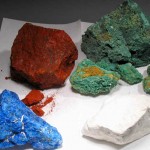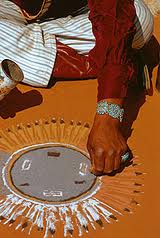Native Americans and Earth Paint

Ochre was the first color paint on this planet. It has been used on every inhabited continent since painting began, and it’s been around ever since, on the palettes of almost every artist in history. In Swaziland, archaeologists have discovered mines that were used ATLEAST 40,000 years ago to excavate red and yellow pigments for body painting. Native Americans are known for their body paintings and I just read that the first white settlers in N. America called them “Red Indians” because of the way they painted themselves with ochre. It acted as a shield against evil and also protection against winter cold and summer insects. Like the Aboriginals in Australia and most indigenous cultures, they considered ochre sacred and infused it into their everyday objects like clothing, tools, pottery, rawhide, etc. Trade for pigments among tribes and later with European traders expanded their palette of colors. The ancient art of Sand Painting among tribes in the Southwest took advantage of the great geologic range of natural colors in their environment and was a form of religious expression. In its original form, Sand Paintings were created to exist only a few hours. But a movement by Native Americans in the latter half of the 20th Century created permanent Sand Painting as an art form.
Make a Sand Painting
Ingredients
- 1 cup Craft Sand
- 1 teaspoon earth pigment
Place sand in a glass jar (not plastic) and add the desired amount of pigment. The amount given is only an approximation. Shake vigorously to coat.
Since pigments are not dyes, their fine particle size mixes with the sand to coat it, but does not actually dye it. Therefore this is not a colorfast application. However, coloring sand by hand and choosing single or combinations of pigments gives you an infinite range of colors that cannot be matched by store bought craft sand.
Tips for sandpainting
- Work with only one sand color at a time. Finish all areas of that color before proceeding to a new color.
- It is preferable to do dark colors before light ones.
- Upon completion of all colors, you may notice some powder or sand has invaded other areas of a different color. The use of a can of compressed spray air, such as that used to clean computers (found in Office Supply) will blow this excess off once all areas are completely dry. Compressed air is also useful for dusting and cleaning sand paintings.

